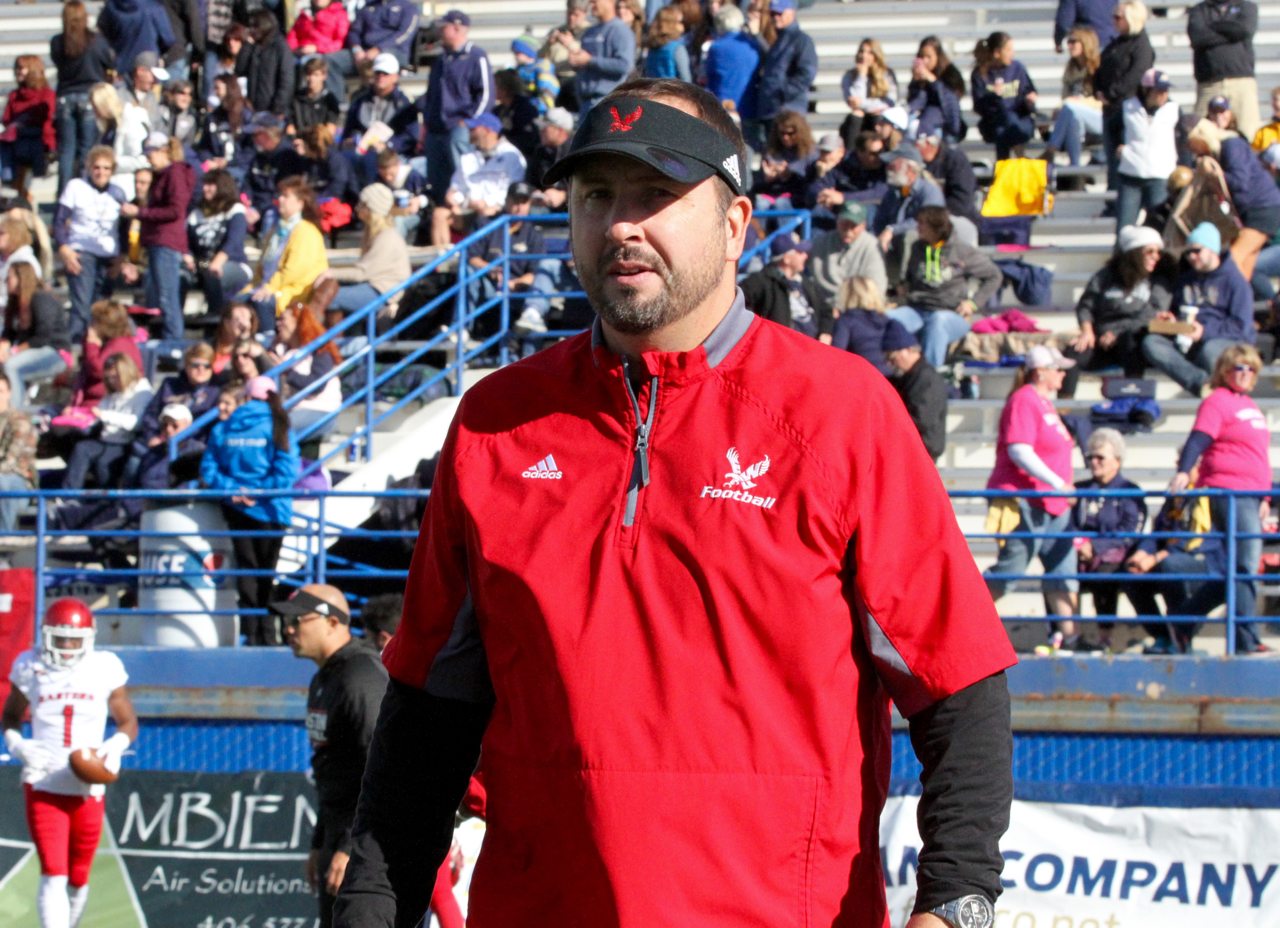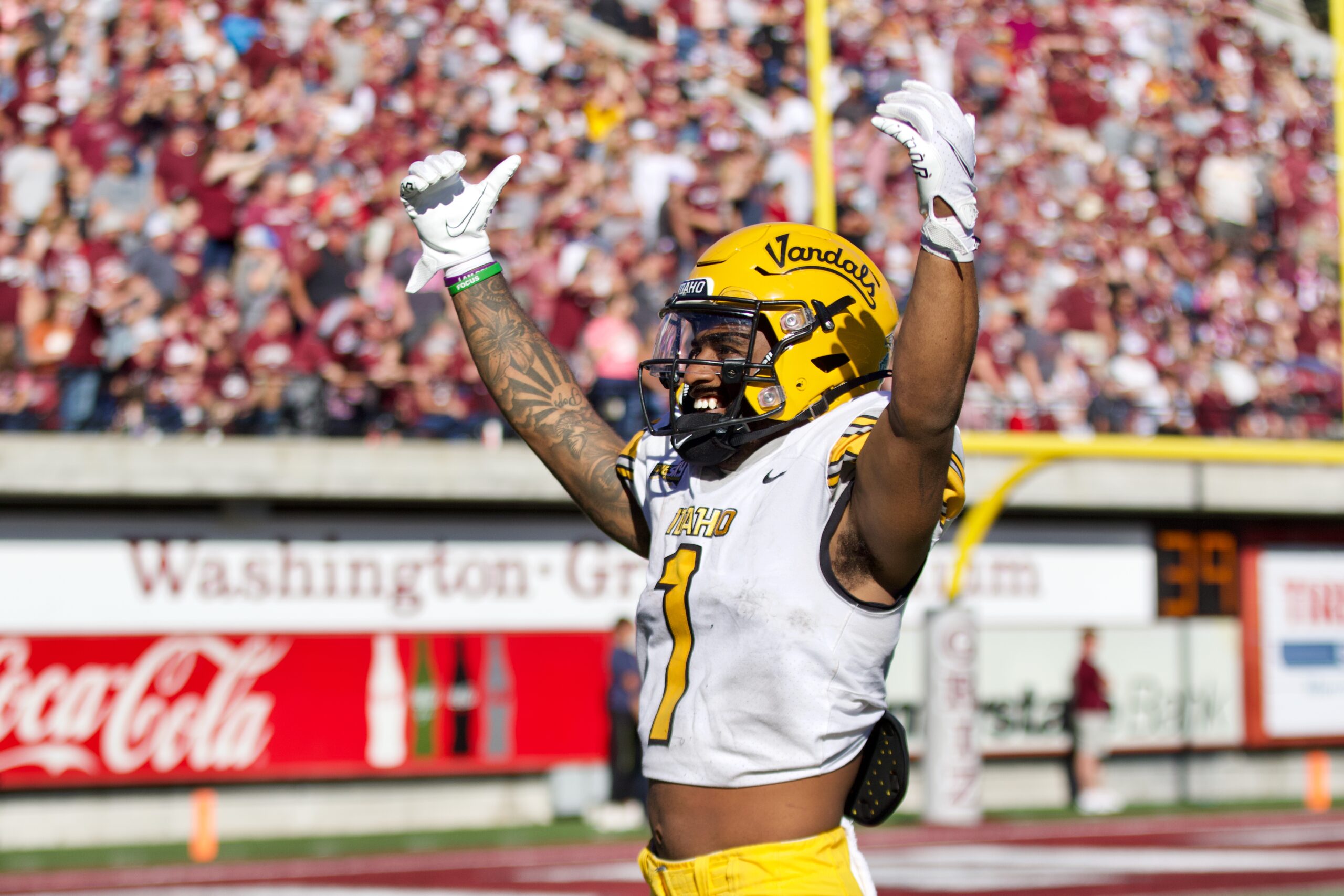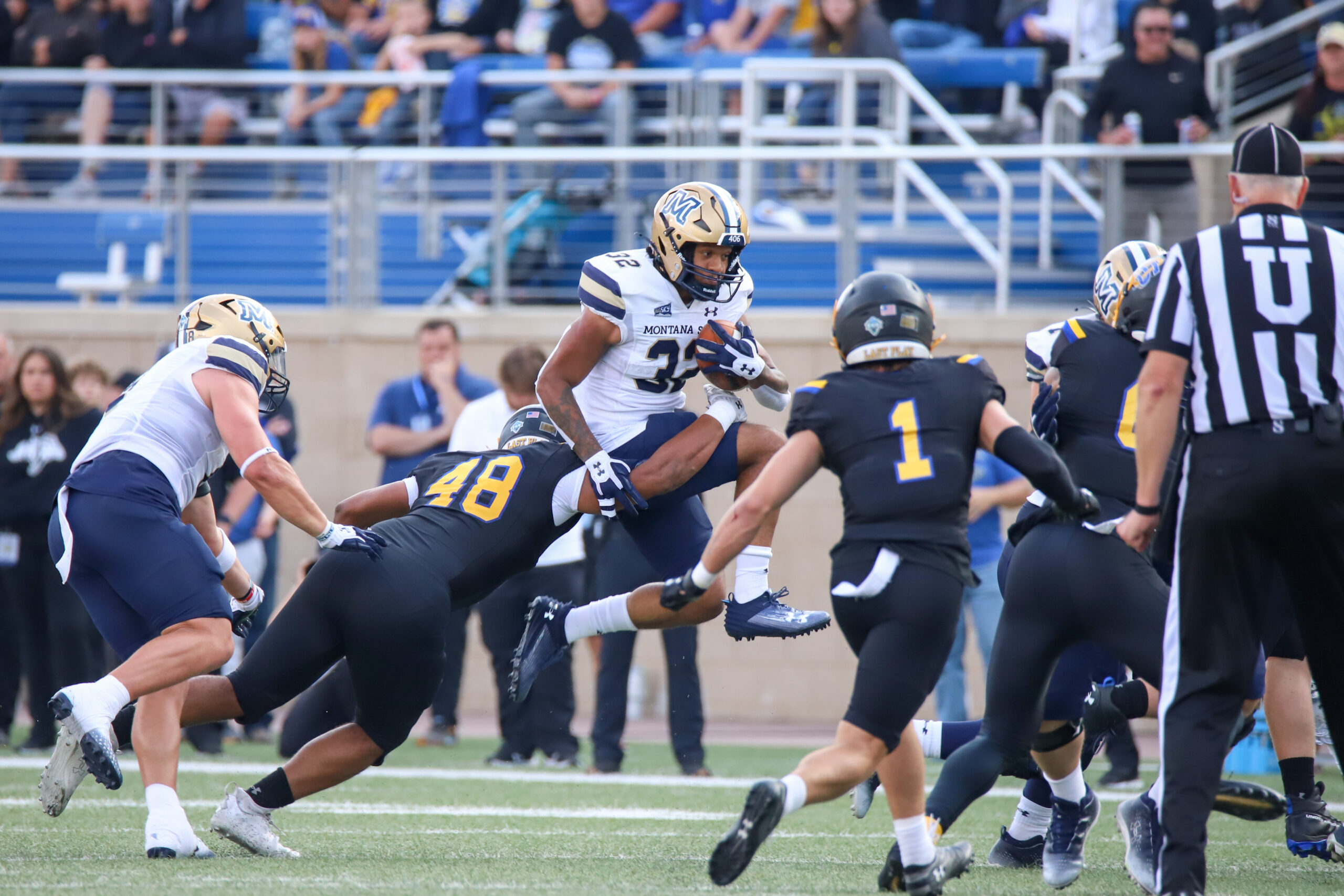Way before the bonkers ending, way before the fourth quarter that saw two lead changes in the final two minutes and the winning touchdown called out-of-bounds by a matter of inches, the Montana State-South Dakota State game made me sit up on the couch like Leo DiCaprio – and stare quizzically at my beer can for an unexpected listing of wormwood in the ingredients.
Wait. Wasn’t SDSU wearing the all-black uniforms?
On their second drive of the game, the Jackrabbits went empty backfield, motioned All-American running back Isaiah Davis next to quarterback Mark Gronowski and had Davis lead the way on a quarterback keeper.
It was a sequence that looked directly ripped out of the Montana State playbook. As a matter of fact, the Bobcats had already done the same thing – starting running back Julius Davis wide and then motioning him into an empty backfield – on their third play of the game. It’s not an uncommon shift – as the announcers explained, it’s an easy way to diagnose if the defense is playing man or zone coverage – but it drove home just how similar the No. 1 Jackrabbits and No. 3 Bobcats looked on the field.

The illusion didn’t disperse until the final whistle, as MSU and SDSU leaned on each other like two equally-matched heavyweight fighters in a game that wasn’t decided until Clevan Thomas’ apparent walk-off touchdown for the ‘Cats was ruled out-of-bounds with one second on the clock and Sean Chambers’ subsequent Hail Mary fell short of the end zone.
In the last few years, Montana State and South Dakota State have hit on the same winning formula – line up five dominant offensive linemen and multiple tight ends, and bludgeon everybody by running the ball until they break. There are slight differences. Montana State is fully committed to running the ball, while SDSU can sling it a bit with Mark Gronowski and NFL-bound Chris Oladokun when Gronowski was out; the Jackrabbits have had a succession of All-American and NFL-bound running backs in Zach Zenner, Pierre Strong and now Isaiah Davis, while MSU seems able to turn anyone off the street into a 100-yard-a-game rusher. But the principles and personnel are similar.
Like Tyson Fury, they can dance around you if they need to. But they’d rather just lean on you and make you feel their weight until there’s no fight left.
SDSU put offensive linemen Garrett Greenfield and Mason McCormick, as well as Davis, on the FCS STATS preseason All-American first team, while Montana State had offensive lineman Rush Reimer on the second team. The ‘Cats were second in the country in rushing last season at 311.9 yards per game, while Davis averaged over 100 yards a game for South Dakota State and the Jackrabbits were in the top 30 in the FCS in total rushing (their 30th-place finish was a bit of a negative outlier too, as they’d finished ninth in 2021, two spots behind Montana State).
It’s proven to be an effective recipe, and the power run game of those two, plus SDSU’s eternal rival North Dakota State (which finished fourth in the country in rushing offense last year and has had an offensive lineman picked in the top four rounds of each of the last three NFL Drafts), has defined the meta at the top of the FCS for the better part of the last decade.
The trio of powerhouses have combined to make up three-quarters of the national semifinalists – and both national championship participants – each of the last two seasons. With Sam Houston State and James Madison both decamping for the FBS, the last current FCS team that wasn’t MSU, SDSU or NDSU to play for the title was Eastern Washington in 2018. The last to win was also the Eagles, all the way back in 2010.

North Dakota State’s stranglehold on the national championship in the 2010s was often cited as a problem for the future of the FCS. If the same team is going to win every year, the thinking went, why bother tuning in?
The rise of the Jackrabbits and the Bobcats partially allayed that fear, but watching Saturday’s game created another. Sure, there are three contenders now. But does it really matter who lifts the trophy at the end if they all look the same? Part of the allure of the FCS is its reputation as a breeding ground of diverse styles, dating all the way back to when Boise State used a run-and-gun offense to claim the 1980 Division I-AA national title, just the third national championship in the subdivision’s history. Montana State used a precursor to the modern spread offense to make a run to the 1984 title, a championship campaign sandwiched between a 1-10 campaign in 1983 and a 2-9 finish in 1985.
Whether it was Idaho’s vaunted and game-changing single-back offense under Dennis Erickson and John L. Smith or Montana’s version of the Mouse Davis run-and-shoot employed by legendary head coach Don Read as UM won the 1995 national title, the Big Sky Conference has been home to plenty of offensive innovations in the 45-year history of the subdivision.
Times change, though, and Saturday’s game raised the question — is there room to innovate and contend?
Like it or not, the top of the FCS is defined by the power run game, and the trio at the top does not appear likely to let anybody else crash the party.
Some 1,500 miles west-southwest of Brookings, the Idaho Vandals provided a counterpoint Saturday in their 33-6 thrashing of FBS Nevada. There have been plenty of interesting narratives in Idaho’s near-instant resurrection under Jason Eck, one that saw the Vandals assume the national spotlight last year after beating Montana in Missoula and continue to draw hype with a preseason top-10 national ranking this season despite not winning a playoff game. Although Eck was previously the offensive coordinator at South Dakota State, his current offense in Moscow is a balanced but high-powered attack driven by Walter Payton Award candidates in sophomore quarterback Gevani McCoy and junior wide receiver Hayden Hatten.
At least to me, what makes the Vandals so intriguing is they could be a potential antidote to the current hegemony of the power run game. With a slick dual-threat quarterback in McCoy and multiple all-conference receivers in Hatten, Jermaine Jackson and Terez Traynor, Idaho, more than any other team in the country, resembles a toned-down version of those Eastern Washington teams of the 2010s that were able, at times, to challenge NDSU.
And if not for a few horrific semifinal losses, Cooper Kupp, Kendrick Bourne and Eastern Washington could’ve challenged NDSU in a few more national title games that the Eagles simply never reached. That 2016 year, in particularly, was ripe for the picking as JMU did the unthinkable and won in Fargo. Eastern had an unprecedented year of offensive production during Kupp’s senior year, yet somehow lost at home in the semifinals to a red-hot Youngstown State team that beat EWU on a jaw-dropping last-second touchdown to essentially end an era in Cheney. Head coach Beau Baldwin left the following off-season to take the offensive coordinator job at Cal.

Make no mistake — plenty of intriguing teams with unique schemes have flamed out in recent years before coming close to the level of the top three (*cough* Troy Taylor’s two-quarterback system at Sac State, which won three straight Big Sky titles and a total of one playoff game).
Two September wins mean nothing about what a team will be in November and December, or whether they can stop North Dakota State from running the ball down their throats in a playoff game in Fargo – the test that every would-be contender eventually has to face. James Madison in 2016 is the only team to go to Fargo and beat the Bison during the post-season since NDSU’s first of nine national championship runs began in 2011.
Heck, even the Montana Grizzlies – despite a combination of resources and tradition nearly unmatched in the FCS – haven’t been able to rise up to the level of NDSU for a decade plus or SDSU for the better part of the last decade or MSU the last handful of years, which says a lot about how far in front of the field those three are.
But the Vandals’ effortless handling of Nevada – they scored a 75-yard touchdown on the first play of the game, and McCoy finished 15 of 21 for 313 yards and two touchdowns – was a statement on the national stage. They’ve recruited well enough, first under Paul Petrino and now under Eck, to be one of the very few teams in the country with overall depth of talent to even be in the conversation with the top-tier triumvirate. Saturday’s win got them a boost to No. 5 in the country and one, uh, particularly optimistic first-place vote in the FCS STATS poll.
On the other hand, though, maybe we should all be so optimistic. Saturday’s top-three clash in Brookings was thrilling and suspenseful, sure. But watching it made me hungry for something different – hungry enough to anoint the still-unproven Vandals as a potential remedy.












